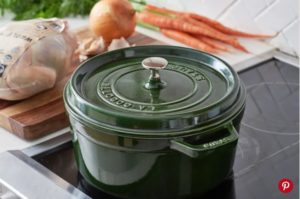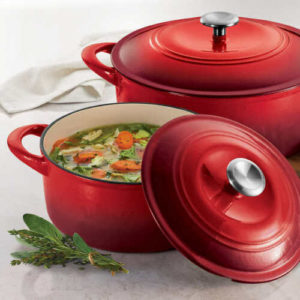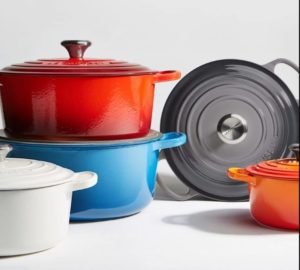Induction cooktops allow for quicker cooking, more straightforward techniques with just a few buttons, and, most importantly, there is no need to stand or monitor food periodically to prevent accidents.
The induction cooktop eliminates all the difficulties associated with cooking, making every day cooking a breeze.
And since many of us also use Dutch ovens at home, an obvious question for many who plan to purchase or own induction hobs is whether Dutch ovens are compatible with induction cooktops.
And now for the good news: The Dutch oven is compatible with the induction cooktop. Your Dutch oven may be large and heavy, but its iron construction ensures magnetic compatibility for cooking.
This means that a Dutch oven is fully compatible with induction cooking and can be used on any induction stovetop.
Now that we know Dutch ovens can be used on induction cooktops let’s examine what Dutch ovens are and what precautions must be taken when using them on induction cooktops.
I highly recommend the Lodge enameled cast-iron Dutch oven if you’re looking for a Dutch oven on an induction cooktop. It is attractive, durable, and works extraordinarily well with induction stoves.
Dutch Ovens Usefulness
Since colonial times, Dutch ovens have been valued for their versatility and durability as cookware.
They serve various functions, including boiling, stewing, baking, frying, and roasting. They are well-suited for long and slow cooking, such as roasting, stewing, braising, and casserole preparation.
Exciting aspects of Dutch ovens:
The value of Dutch Ovens can be deduced from the fact that 18th- and 19th-century wills frequently specified the desired inheritor of Dutch ovens. Additionally, the Dutch oven is the state cooking vessel of Texas and Arkansas.
How Induction Operates Using a Dutch Oven
A Dutch oven is cooked on an induction cooktop by transferring heat generated by magnetic energy to the Dutch oven. It generates instant heat, consumes 50 percent less electricity, and cooks’ food faster than conventional cooktops.
A coil of copper wire is located under the cooktop. The passage of an alternating current through this wire generates a magnetic field. Being ferromagnetic, the Dutch oven’s base allows magnetic energy to pass through.
This induces a strong, resisting, swirling eddy current that generates heat. This heat is what causes food to cook. It is essential to note that the heat is contained within the cookware.
No radiant heat, open flame, or red-hot coil is present. Since heat is contained within the cooking vessel, this cooking method is safe and energy efficient. Only the area beneath the Dutch oven becomes hot; the remainder of the surface remains cool to the touch. Approximately 90% of the energy generated by the induction hob is utilized for cooking food.
A benefit of using a Dutch oven on an induction cooktop is the ability to control the heat with the induction buttons precisely. Additionally, cleaning up after cooking with induction is very simple, as very little mess is produced.
In addition, it cooks the food in half the time required by a conventional cooktop. Once the Dutch oven is removed from the cooktop, the heat source is no longer present. This eliminates the possibility of an accidental fire.
Precautions to Take When Using a Dutch Oven on Induction
Dutch ovens performed optimally when heated slowly and kept warm. Avoid heating it at high temperatures before use. This can cause the food to burn or stick due to the efficient heat transfer.
They can become extremely hot and evenly distribute heat throughout the entire piece of cookware. Maintain mitts or trivets in readiness for removal from induction. Also, avoid abruptly causing temperature changes from hot to cold, from a refrigerator to an induction range.
Temperature changes can cause the enamel to crack! Cast iron can easily scratch induction cooktops’ glass surface, which is the only negative aspect of working with inductions.
Something thin should be placed between the Dutch oven and the induction cooktop. It could be anything from paper napkins to newspapers to parchment paper to Silpat mats.
Since induction utilizes magnetic fields, the cooking surface does not heat up, and the paper does not catch fire. This will prevent scratches and splatters on the induction cooktop’s glass surface.
Due to electromagnetic energy transfer, Dutch ovens must also have a flat bottom to function optimally on an induction cooktop. Ovens with a round bottom will not perform as well.
Invertor discs are available for use with rounded Dutch ovens, but I recommend purchasing a Dutch oven with a flat bottom. The rationale for not preferring the inverter disc can be found in this article.
For effective electromagnetic induction, the bottom of the Dutch oven must be smooth. If the base is not smooth, use sandpaper to smooth it.
Placing an ordinary magnet on the bottom of your Dutch oven is an excellent way to determine whether it is compatible with induction. If something adheres, it will undoubtedly work on an induction cooktop.
It will also function if the ditch oven is made of magnetic stainless steel. The ferromagnetic property of iron will heat the cookware’s surface, so an all-clad iron will undoubtedly work.
Coat the bottom of the Dutch oven with oil, fat, butter, or water before adding dry ingredients. This is done to prevent food from sticking and burning.
The surface of vitreous enamel is not porous. This means you can safely cook acidic foods on the induction range. Example- wine, tomatoes, lemon, etc. Avoid dragging or thumping it on the induction glass surface. With sufficient force, the heavy cookware can crack or break the glass.
The use of wooden ladles is preferable to ferromagnetic spoons. Spoons made of wood are less likely to scratch the interior of a Dutch oven. To continue using your Dutch oven on an induction range, ensure that it is scorched and oiled to prevent rust.
FAQs
Aluminum, ceramic, copper, and glass cookware cannot be used on an induction oven. Xtrema’s pure ceramic cookware does not contain ferromagnetic or iron materials, so it should only be used on a gas, electric, or glass top stove.
Le Creuset enameled cast iron cookware can be used on all heat sources including gas, electric solid plate or radiant ring, vitro-ceramic glass, induction, and ovens fired by gas, oil, coal or wood.
Induction uses magnetic fields to heat cookware, so your pan must contain conductive, ferrous metals to transfer heat. This makes cast iron a great option for induction cooking.
Cast iron, enameled cast iron, and many types of stainless-steel cookware are all induction compatible. There are exceptions, though. For instance, All-Clad’s MC2 line, which is made of aluminum and stainless steel, is not induction compatible.
Dutch ovens made from cast iron can be used on a glass-top stove and are great for whipping up soups and stews for dinnertime. To avoid damage, make sure the bottom of the cookware is smooth, and avoid dropping or sliding the Dutch oven across the glass surface.
Ceramic cooktops contain coiled metal elements underneath the tempered ceramic glass. These are heated electronically, which then heats the ceramic glass surface and warms the pan. Induction cooktops feature powerful, high-frequency electromagnets under the surface, rather than metal coils
There are many types of cookware that cannot be used on the induction: Aluminum or aluminum clad, copper or copper clad, aluminum foil, glass/ceramic and some stainless steel products (because these will not attract and hold a magnet).
Most damage to any glass-topped hob comes when we slide pots and pan onto the hob. So, to stop scratches on your brand-new induction hob, place your cast iron Le Creuset cookware down, rather than sliding it.
All Le Creuset Cast Iron, Stainless Steel and Toughened Non-Stick cookware is perfect for induction cooking, so you can choose your favourite, whether it is a bright and beautiful enamel-coated cast-iron casserole or skillet grill, a sleek and shiny
The stoneware range products do not have iron or cast iron materials. This is why these are not for use on induction stovetops.
Conclusion
Finally, can a Dutch oven be used on an induction cooktop? Indeed, it will. Any cast-iron cookware is perfectly acceptable.
Remember that you are handling heavy cookware. Notably heavier than comparable cookware. Being cautious will safeguard your induction cookware and facilitate the cooking process.
Remember the guidelines above when using Dutch ovens on an induction cooktop, and you will be fine. You can use this super-durable and versatile Dutch oven on an induction stove without worry if you take the necessary precautions.
In addition to its numerous advantages, if you ever decide to switch your cookware, this masterpiece is compatible with all cooktops!
Related Posts
Best Dutch Oven for Induction Cooktops
Disclaimer: There are affiliate links in this post. At no...
Read MoreBest Dutch Oven For Glass Top Stove
Disclaimer: There are affiliate links in this post. At no...
Read MoreReviews of Tramontina Dutch Oven
Disclaimer: There are affiliate links in this post. At no...
Read MoreLe Creuset Dutch Oven Sale
Disclaimer: There are affiliate links in this post. At no...
Read MoreWhy Trust Us
You will find what you are looking for at dulceriabakery. From classic to luxury brands, you'll find both. We will help you to select appliances that fit your needs, budget and lifestyle. Whether you want to stop by to learn more — or plan to make a major purchase — we’ll treat you like family and assist you every step of the way. Shop with us today to receive friendly and experienced help along the way.



